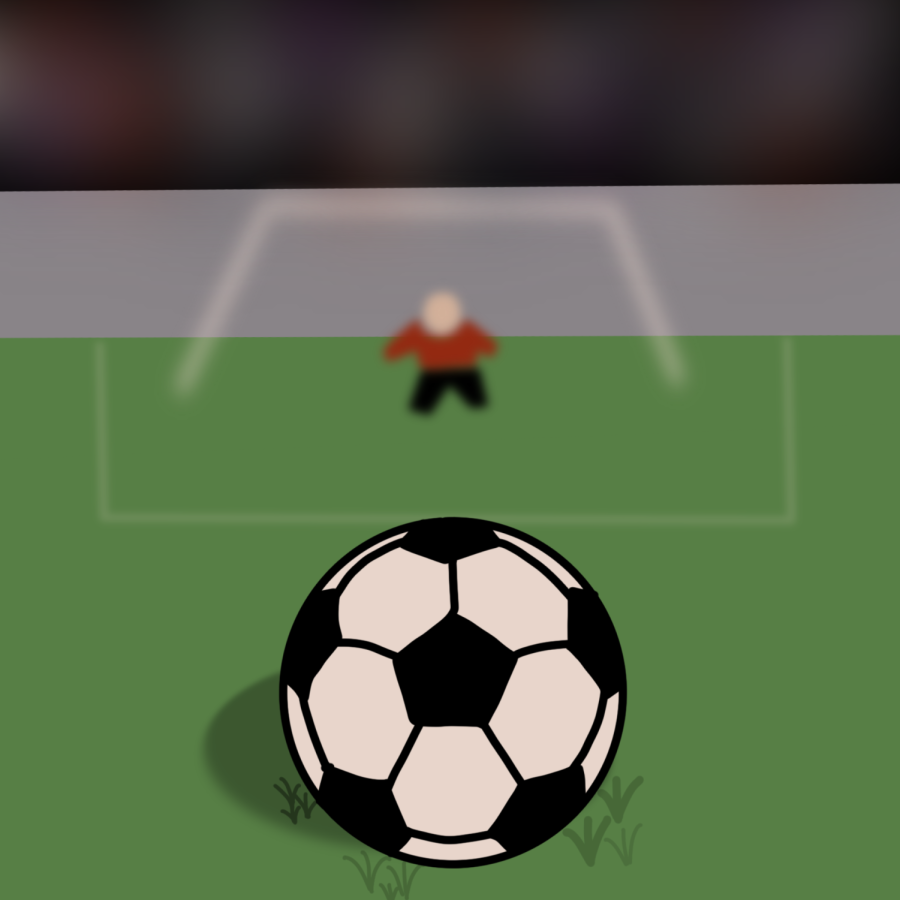Penalty shootouts need to go
August 30, 2022
Picture this scenario: you have been playing a game of soccer for 90 minutes, but ultimately, the score is tied. After all of the hard work you have put in running up and down the field shooting, crossing and passing, the end score will come down to a single kick. Unfortunately, the odds of your team winning do not even amount to a 50/50 chance. Now, factor in the coin toss at the beginning of the game that determines which team kicks first. If your team loses the coin toss and kicks second, your chances of winning have decreased to 40%. This is because the team kicking second is having to play catch-up for the rest of the match.
In a penalty shootout, each team will take turns shooting at the goal from the penalty mark. The goal will be defended by the opposing team’s goalkeeper only. Then, each team will have different kickers take five shots at the goal. The team with the most successful kicks will be the winner. If the score is still tied, the shootout will continue until there is a victor.
When a game comes down to a penalty shootout, it can be intense. However, this way of breaking the tie between two teams completely conflicts with the true nature of soccer. By using this tie-breaking process, it becomes one player versus another. However, soccer is meant to be a team sport. Soccer consists of the players working together and maintaining communication to win the game. If a game comes down to a penalty shootout, one bad kick or one good save can completely alter the results of the game. The shootout does not depend on skill, but rather on pure luck. If the keeper dives the wrong way, you could pass the ball anywhere along the ground and score.
Another downside to penalty shootouts is when you are the unlucky one defending the goal. As you stand between two white sticks and a player fires at you from 12 yards, you’ll experience five times the stress, and your whole team will be infuriated if you do not dive to protect the goal.
Looking back in history, this was the best alternative for breaking a tie between the two teams. Before penalty shootouts were integrated into the game, ties would often be broken by either a coin toss or a replay. The problem with a coin toss is it’s unfair and is based solely on luck. Replays were not a good option either as they took more time and were physically more taxing on players.
Obviously, there are going to be flaws in every alternative to penalty shootouts. However, there are other options than what we currently have in place that stay more true to the nature of how soccer is meant to be played. One popular alternative to penalty shootouts is Attacker Defender Goalkeeper (ADG). ADG pits an attacker against a defender and a goalkeeper with 20 seconds to score. ADG is similar to a penalty shootout but differs by including more members of the team. Each team will elect five attackers, five defenders and a goalkeeper. Some of the advantages of using this system rather than penalty shootouts are that more players get to compete and it showcases their skills.
In short, there is not a perfect solution to break the tie in a soccer match, but there are other alternatives to improve the overall gameplay and preserve the nature of the sport, rather than relying on luck to decide who wins.








Kimathi Ibrahim • Sep 16, 2023 at 9:46 am
Penalty shootout is the worst method of deciding which team should book a place in yhe next round of any football tournament. The fact that a team could play 100% defence and zero offence and have an equal chance of winning on penalties doesn’t feel right. Penalties are relatively rare in regular play. When they do happen, there are a select few players on each team who hold that responsibility.
The skills required to score a penalty during a shootout are different to those required to play football for 120 minutes. Players must walk up to the mark from halfway, then walk back after their shot. That’s a long 40-metre walk of shame for those who miss. Why? Those who do miss will never forget that they missed, nor will their fans.
To have games decided by a process that relies less on players performing excellently and more on players failing spectacularly feels backwards. It diminishes the satisfaction for those who win, and adds unnecessary humiliation to those who lose. it’s ridiculous. There’s got to be an investigation into this.
Watch any shootout. As the players walk up to take their kick, their faces range from distressed to physically ill to “I wish I’d chosen table tennis”. It’s a format designed to cause excessive anguish and embarrassment to anyone who, God forbid, has their spot kick saved by a world-class 1.96m-tall highly athletic goalkeeper – with long arms and hands of steel – patrolling a 7.32m x 2.44m goal.
In today’s world, there’s an emphasis on protecting mental health and safeguarding people’s emotional wellbeing. Surely a penalty shootout is unduly cruel and a recipe for ongoing mental trauma.
“Football can be a drama, even a tragedy, when we go to penalty kicks. Football should not go to one to one, because when football goes to penalty kicks, it loses its essence as a team sport.” That was said by none other than Sepp Blatter.
When a competition reaches the final stage whereby a team is underdog a penalty shootout will give the weaker team a much larger chance of winning when compared to even more extra time! With that noted, when it comes down to it the underdog has much less experience and training for penalty shootouts.
Watching any penalty shootout fans everywhere of soccer’s elephant in the room, penalties. The penalty shootout is the one glaring error in a beautiful, near-perfect game. After 120 minutes of battling for each yard and each shot, the game is finally decided by a combination of luck and some level of mind games. The penalty shootout ignores so many aspects of the game. While shooting is obviously a major part of soccer, the shootout eliminates passing, spacing, dribbling, teamwork, physicality, and many forms of tactics from the game. We boil down our beautifully sculpted sport to a backyard shooting contest.
I have some really absurd examples. In the 1986 FIFA World Cup, three out of four quarter finals went to the dreaded shootout. Lucky it was won by the exceptional semi finalist, Argentina. Both 1990 FIFA world cup finalists (West Germany and Argentina) won shootout semis. Argentina frustrated a much better team in the semis, ITALY.
A very average Argentina won two penalty shootouts (also beat Yugoslavia in Quartes) on their way to meeting the tournaments best team, West Germany. Croatia after a scintillating group stage performance zombied their way to the FIFA World Cup final 2018 by winning two penalty lotteries. Their other knockout game was won after extra time. Argentina lost their 2022 world cup opener to Saudis and needed two penalty shootouts to lift the cup.
Both Euro 1996 finalists needed spot kicks to win their semis. Their respective opponents made it that far thanks to… you guessed it! SOCCER LOTTERY. Did the best teams contest the final or win it? It is hard to argue that Italy was not the best team at EURO 2020. That said they failed to qualify for both 2018 and 2022 world cups. No wonder they needed to win two penalty shootouts. At afcon 2021 played last year Egypt came so close to winning a third shootout at the same tournament and win the title while at it.
The worst of the worst shootout tragedies must be LIBYA winning the 2014 CHAN (A version of AFCON played by domestic players). They played six matches and won only one against Ethiopia and drew all the rest. All three knockout rounds were won by tragic spot kicks. ABSURD.
The Solution
I have ranted enough. Of all football stats (total shots attempted, shots on target, blocked shots, fouls committed, corner kicks won, ball possession, aerial duels won, clearances, throw ins, passing success, offsides, yellow cards, red cards etc.), I found three combinations that are pointing to the team that is playing to win. These are the team with more corner kicks won, fewer fouls committed and less ball possession.
Ball possession is sometimes abused and applied to hoard the ball. I use the word hoard intentionally because I don’t see the point of having 70 % and failing to outscore (Goals are the only statistic that matters currently in football) your clearly technically inferior opponents. Possession was never meant to be used defensively. It must be used to win matches, otherwise that is another form of Antifootball tactics. It is like penalising the one who controlled the game without having anything (outscoring your opponent) to show for it. That will act as a deterrent against ball hoarding and possessing for the sake of it. This will also encourage teams to possess the ball in areas they can hurt opponents hence opening up the game. The team with lower ball possession percentage in the match earns one point.
Fouls. I like to see this as players trying to get away with as much as the rules and the match referee can allow or take. In recent times we have had a lot of teams in the junior FIFA competitions eliminated at the group stage on fair play points. The best example was at the senior level, with Senegal national football team eliminated and Japan proceeding to the last 16 round of the 2018 FIFA World Cup. Team with fewer fouls in the match earns one point.
Corners. No other football statistic shows attacking play of a team than the number of corner kicks won. Remember that teams must play offensively to get that all important goal(s) to outscore the opponent. Team with more corner kicks earns one point. By considering shots on goal as one of the metrics, then we will be nulliifying the importance of a goalkeeper in this team sport. Total shot attempts is even worse because some of these efforts are closer to the corner flag than the near post. Considering this in the count to determine the winner after 120 minutes will mean teams stop playing football and shoot from their own halves or goalkeepers will kick acroos to earn the all important points.
For example in a match where Team A has 68% possession, 22 fouls aginst 31 and won 12 corner kicks agaist 7 and the match is still 0 -0, then they will be leading 2 -1 on points. Their two pointscoming from less number of fouls and more number of corner kicks. The opponent (Team B) gets the other point for holding their rivals level (0 – 0, remember the fact that it is only goals that matter in football still holds ) with just 32%. If the losing team (on points system) scores in the 115th minute of extra time, they move from 1 – 2 to 1 – 0 WIN). I am sure this will reduce the number of drawn matches in knockout football.
Penalty shootouts have been there for 50 years. It is time for radical change in the game that we so much love, my friends.